|
Ed
George
Ruff senior (1826
- 1903) -
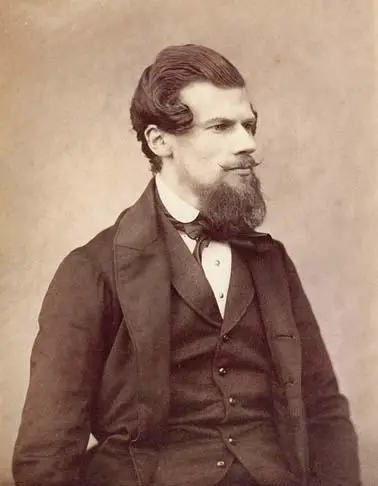
George Ruff senior.
Self portrait c1860. Albumen print from the collection of
Philippe Garner. [ COURTESY OF PHILIPPE GARNER
]
|
Artist
and Photographer
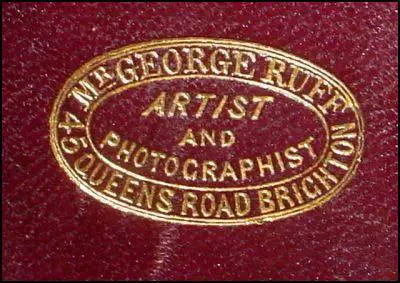
George
Ruff senior's trade plate marked in
gold lettering on a leather ambrotype case (c 1858)
|
George
Ruff senior - Artist
George
Ruff was born in 1826, the son of Charlotte and George Ruff, a shoemaker
of Gloucester Street, Brighton. George's baptism was recorded in Brighton
on 27th October 1826. George's father is believed to have originated
from West Sussex, but by 1824 he was working as a shoemaker in Sussex
Street, Brighton. In November 1825, George Ruff the shoemaker married
Charlotte Snelling of Brighton. The following year, Mrs Charlotte
Ruff gave birth to her first, and probably only child, George. After
George Ruff's father died, his mother set herself up as a greengrocer
and opened a shop in Brighton. As early as 1845, Mrs Charlotte Ruff
is recorded as a greengrocer at 46 Richmond Street. In an 1848 Brighton
directory, George Ruff ( presumably Mrs Ruff's 22 year old son ) is
listed as a shopkeeper of 46 Richmond Street.
At
the time of the 1851 Census, Charlotte Ruff is recorded as "
Fruiterer - Greengrocer", a widow, aged 48, residing at 46 Richmond
Street, Brighton. Mrs Ruff's only son George, who was already working
as an artist, is described as a " Painter in Oil & Watercolour".
In 1850, George Ruff had executed a watercolour of Hove Church, which
is now owned by Brighton Museum & Art Gallery. Around the same
time, the 24 year old artist probably made a daguerreotype of St Nicholas
Church, one of the earliest photographic images of a Brighton building
to have survived.
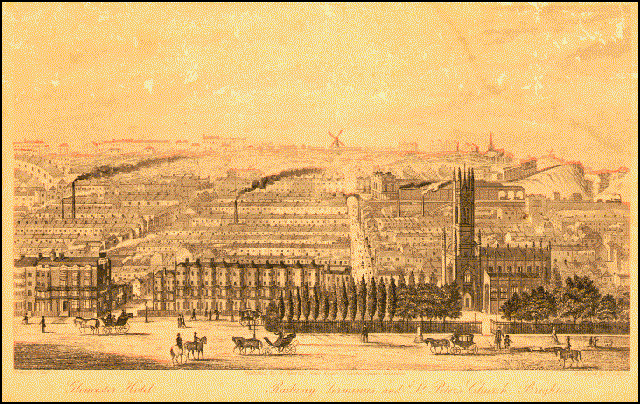
View
of Brighton.( c1851) An engraving taken from a drawing by George Ruff
senior. St Peter's Church can be seen on the right. In the centre,
Trafalgar Street runs up to Brighton's Railway Terminus. The Gloucester
Hotel can be seen in the left foreground. This is the view
that would have been seen from Richmond Street, where George Ruff
was living at the time.
In
the 1850s, George Ruff produced a number of paintings which represented
scenes in Brighton and the surrounding countryside. In 1851, he painted
watercolours depicting the Lodge at Brighton Cemetery, the Royal Pavilion,
Preston Paygate and a view of the Queens Road in Brighton. In 1853,
Ruff completed an oil painting of Brighton Beach, which like a number
of his painted works, now resides in the collection of the Brighton
Museum & Art Gallery.George Ruff also exhibited his work in London.
At the Society of British Artists, George Ruff senior exhibited seven
watercolours, including the paintings " Broadstairs with the
North Foreland Lighthouse" and " Kitchen Garden".
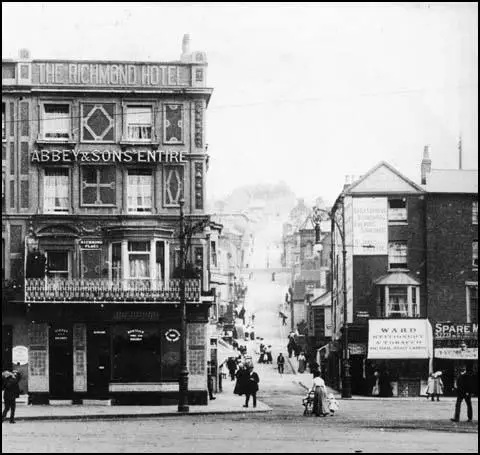
Richmond
Street, Brighton (c1900). In this photograph Richmond Street is the
steep street that runs between The Richmond Hotel on Richmond Place
and the small parade of shops at the western end of Grand Parade.
Mrs Charlotte Ruff, George's widowed mother, owned a fruiterer and
greengrocer's shop on Richmond Street from about 1845 to 1854.
George
Ruff probably did not sell enough paintings to make a living as an
artist. By 1855, he is listed in a local directory as a greengrocer,
running a shop for his mother at 102 Richmond Street, Brighton.
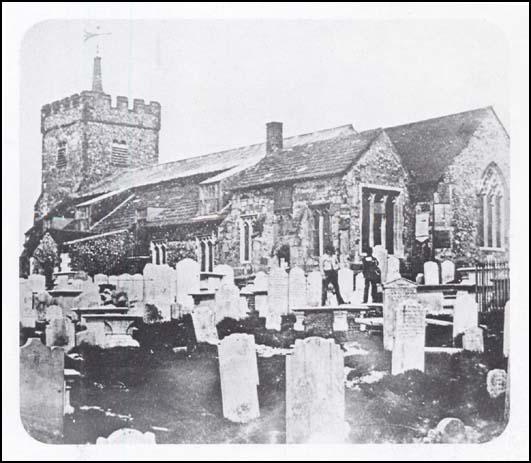
St
Nicholas' Church (c1850). A photograph which is believed to be a copy
of a daguerreotype by George Ruff senior.The original photograph was
passed down to Aubrey Ruff, George Ruff senior's grandchild.
Mr
George Ruff - Artist and Photographist
George
Ruff became a professional photographer around 1855 and is first listed
as a photographic artist in Folthorp's Brighton Directory of 1856.
Ruff's home and studio address is given as 45 Queens Road and he was
to work in this building as a photographic artist for the next twenty
years. Advertisements proclaimed that his studio at 45 Queens Road
was located "exactly opposite the Eye Infirmary" and was
"open from ten till nearly dusk" , adding that portraits
were taken "in any weather". His cased portraits carried
the words "Mr George Ruff - Artist and Photographist"
|
Ed
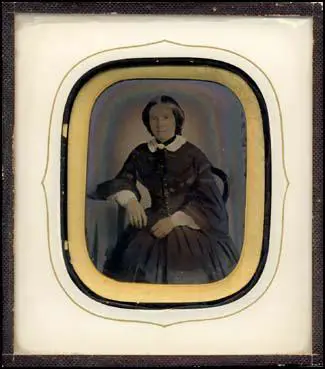
[ABOVE]Portrait
of a woman.(c.1860).A positive collodion
portrait (ambrotype) by George Ruff senior.The label states
that the colouring was 'executed entirely by Mr R. himself
'.
|
1
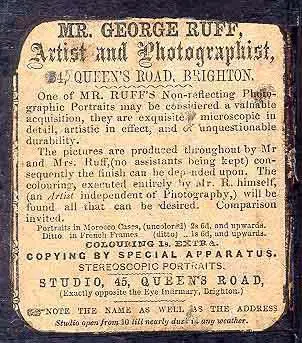
[ABOVE]
This label appears on the reverse of a George
Ruff
collodion portrait ( c 1860).
Ruff called his ambrotypes 'non-reflecting photographic
portraits'. He charged 1s 6d for a portrait in a French
frame and 2s 6d for a cased portrait .
|
In
the late 1850s, George Ruff was producing wet collodion portraits
on glass, which he described as "Non-reflecting Photographic
Portraits". Ruff charged 2s 6d for an uncoloured portrait in
a Morocco leather case. Colouring would cost the customer one shilling
extra. In an advertisement of this period, George Ruff proudly states
that the colouring of the photographic portraits is "executed
entirely by Mr R. himself ( an Artist independent of Photography,)
". George Ruff also specialised in the production of stereoscopic
portraits.
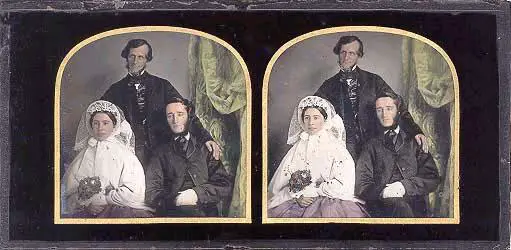
A stereoscopic
portrait of a wedding group by George Ruff senior. Collodion positive
( c 1860)
George
Ruff's Family
By
the time of the 1861 Census, George Ruff had married and was the father
of two children, but his mother Mrs Charlotte Ruff is described as
"Head of Household" and is still in charge of the greengrocery
business.
In
the 1861 Census for the household of 45 Queens Road, the 34 year old
George Ruff gives his occupation as " Artist Photographer",
while George's wife Ruth is described as a "Photographer's Artist",
aged 35. George and Ruth's children were named after their parents.
In the 1861 Census, their daughter Ruth is aged 8 and George junior
is only 2 years of age. George Ruff, the "artist-photographer,
was single at the time of the 1851 Census and so his marriage to Ruth
must have taken place around 1852.
A
few years after the 1861 Census, George's mother retired from the
greengrocery trade and George Ruff became the Head of the Family.At
the time of the 1871 Census, the 69 year old Mrs Ruff appears at the
bottom of the entry and is described as " mother of Head of Household".
George
Ruff's photographic business was a family concern. In an early advertisement
for his studio in Queens Road, Ruff declared that " the pictures
are produced throughout by Mr and Mrs Ruff, ( no assistants being
kept )". In the early years of the business, George Ruff
alone coloured the photographic portraits. By 1861, George Ruff 's
wife Ruth is recorded as the " Photographer's Artist" at
45 Queens Road. George Ruff's daughter also took an early interest
in the photographic art. At a tender age, little Ruth was making portraits
of her dolls. One collodion positive photograph of two dolls sitting
on a chair carries the inscription "Jany (January) 30, 1858,
focussed by Ruthey Ruff , 5 1/4 years".
As a teenager, Ruthey assisted her parents in the photographic business.
The 1871 Census records her at
45 Queens Road
as a "shopwoman",
aged 18.
|
E
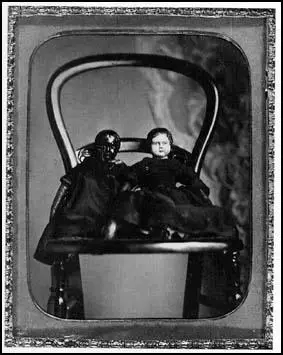
Portrait of Two Dolls. A collodion
positive taken by George Ruff's five year old daughter in
January 1858.
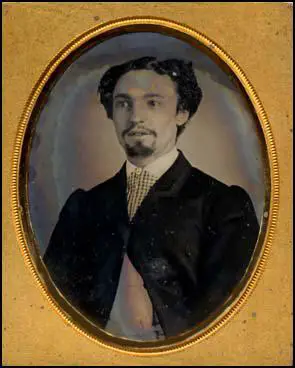
Portrait
of a bearded man c1860. An ambrotype portrait taken at George
Ruff senior's photographic studio at 45 Queens Road.
|
1
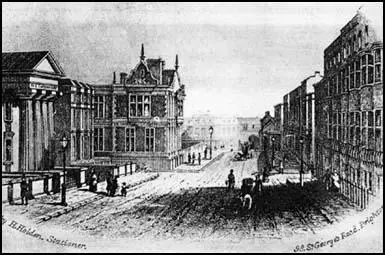
[ABOVE]
Queens Road, Brighton, looking south from the railway
station towards the sea (c1855). Queens Road was constructed
in 1845 to connect the Railway Terminus to North Street and
West Street. George Ruff senior's studio stood directly opposite
the Eye Infirmary, the building with the classical columns
on the left of the picture.
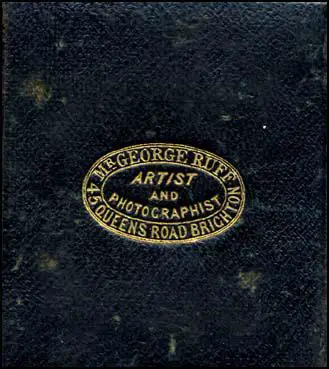
George
Ruff senior's trade plate on an ambrotype case
|
|
Ed
Queens
Road, Brighton (
c1890)
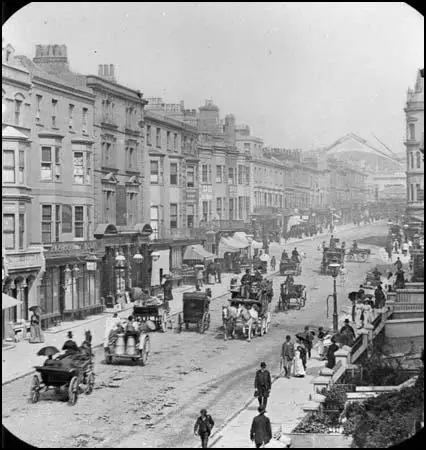
[ABOVE] Photograph
of Queens Road, looking north towards Brighton's Railway Station
(c 1890). George
Ruff senior's home and business premises at 45 Queens Road
stands centre left. On the far left at No 40 is Corrall's
Coal Merchant shop. To the right of Corralls, at No 41-42,
is Thomas Emery's Temperance & Commercial Hotel. The building
with the three round lamps suspended over the entrance is
the Imperial Hotel. Ruff's house stood between the Imperial
Hotel and the Church Extension building and Markwick's Aviary,
the dark building with the group of people gathered in front
of the shop,under the awning.
|
1
41
- 49 Queens Road, Brighton
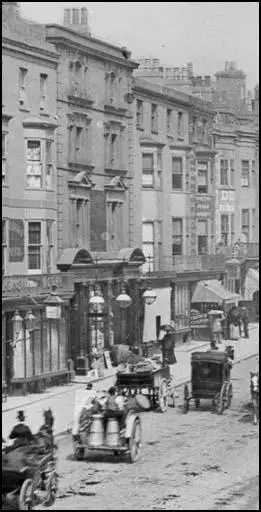
[ABOVE]
A close-up, showing 41-49 Queens Road. George Ruff senior's
home and business premises at 45 Queens Road stands third
from left, the pale building with the white blinds in the
centre of the picture. A woman holding a sunshade, ,just to
the right of the stationary cart, can be seen directly in
front of Ruff's shop.To the left of Ruff's building is the
elaborate Imperial Hotel.
|
George
Ruff - Photographic Artist
George
Ruff was in business as a portrait photographer throughout the carte
de visite craze of the sixties and early seventies.
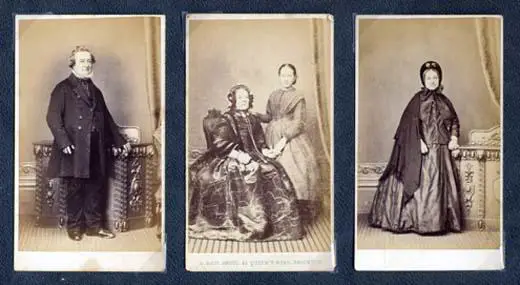
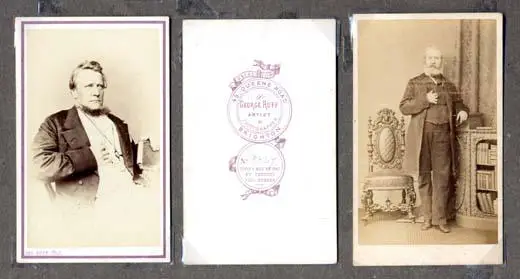
Carte
de visite portraits taken by George Ruff senior at his photographic
studio at 45 Queens Road, Brighton in the 1860s and 1870s.
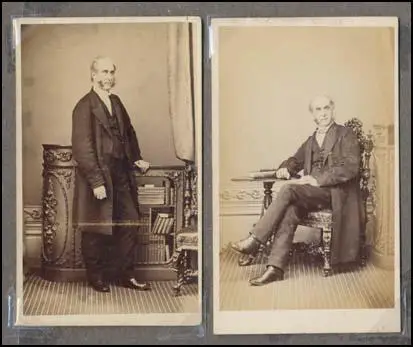
Carte
de visite portraits of Revd. John Grace taken at Ruff's Queens
Road studio around 1864.
George
Ruff senior Returns to Painting
George
Ruff senior is last listed as a professional photographer in 1876.
He appears to have abandoned photography for his first love - painting
pictures. A marine painting , " The Wreck of the Ida of Glasgow
" was completed by Ruff in January, 1877. Around the same
time, George Ruff exhibited a painting called " Old Houses
at Lewes". In September, 1877, Ruff showed two paintings,"Summer
on the Ouse" and "Sunset - Shoreham Harbour "
at the Exhibition of Modern Pictures in Brighton. In 1879, he painted
a watercolour entitled "Shoreham Harbour - Moonrise".
During this period, local trade directories describe George Ruff
senior's occupation as "Artist's Colourman". Evidently,
George Ruff senior made his living by providing paints and pigments
to other artists. However, in the 1881 Census, George Ruff senior
gives his occupation as "Artist ( Painter)". George Ruff
senior exhibited regularly in London during the years 1880 and 1886,
showing landscapes and figure paintings at the Royal Academy, the
Royal Institute of Oil Painters, the Royal Society of British Artists
and the Royal Institute of Painters in Water Colour. George Ruff senior
worked as an artist's colourman until his retirement and he continued
to paint landscapes well into his late sixties. A decendant of George
Ruff , Gill Friend, owns a painting of Cuckfield, painted and signed
by George Ruff senior in 1897. In the 1901 Census, George Ruff is
recorded as a "retired artist" age 74 .Living in the same
household is Ruth, his wife of fifty years. George Ruff senior died
in 1903.
George
Ruff junior ( born c1858 - died c1913 )
|
Ed
George
Ruff junior (1858-1913) -
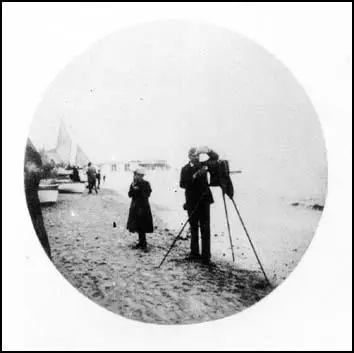
George Ruff junior taking
photographs on Brighton Beach, with his adopted daughter Dorothy
at his side.
|
1
Amateur Photographer
and Artist
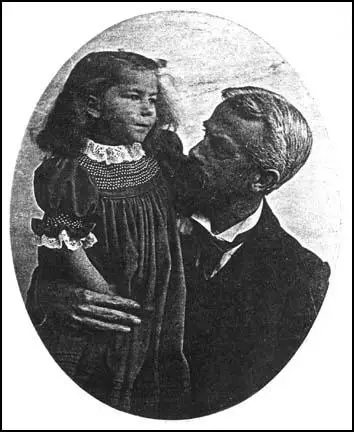
George
Ruff junior with his adopted daughter Dorothy.
|
George
Ruff junior - Artist
George
Reuben Ruff, commonly referred to as George Ruff junior, was born
around 1858. He appears to have inherited his father's interest in
painting and photography. As a young man he studied painting in London,
producing mainly landscapes and still life. In the years 1879 -1880,
George Ruff junior exhibited three paintings, two of which were Sussex
landscapes, and gave a London home address to the gallery. For example,
in 1880, Ruff junior exhibited at the Royal Society of British Artists
and gave his address as 164 Great Titchfield Street, Portland Place,
London. At the time of the 1881 Census, George Ruff is recorded as
" Art Student (Painting)", aged 22, lodging with Thomas Taylor, an
elderly carman of 6 Hill Street, Camberwell, Surrey in South London.
Marilyn Hiles has a painting dated 1882 and signed 'George Ruff',
which she believes was painted by her great grandfather during this
period of his career.
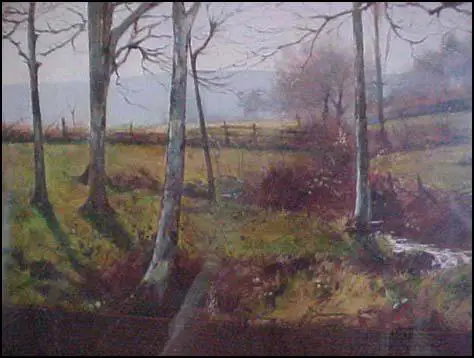
Landscape
by George Ruff junior. This signed painting, dated 1882, is owned
by George Ruff junior's great grand daughter.
By the early 1890s, George Ruff was back in the Brighton area taking
photographs. He made his home in the Preston area of Brighton and
by 1893, George Ruff junior was living at Cambridge Villa, 50 Coventry
Street, not far from Thomas Booth's Natural History Museum on Dyke
Road. In the 1901 Census, George Ruff junior is recorded at 50 Coventry
Street, living with his wife Mary ( born c1869 Salehurst, Sussex ).
He is described as "Living on own Means", aged 42. No children are
listed in the census return. It is known that in 1903, Mr and Mrs
Ruff adopted a young girl named Dorothy. His adopted daughter features
in a number of photographs taken by George Ruff junior. Around 1905,
he captured Dorothy photographing her dolls, an activity that his
sister "Ruthey" performed nearly 50 years earlier. The Ruffs were
also the parents of a son. who they named Aubrey Mortimer. (Aubrey's
grandchildren have a photograph which shows a young girl,believed
to be Dorothy, washing a golliwog in a water butt ). In the 1890s
and the early 1900s, George Ruff junior wandered along the beach and
esplanade of Brighton's seafront, armed with the recently introduced
portable camera, snatching pictures of children paddling in the sea,
boys and girls playing on the beach and other animated scenes. Ruff
junior also captured seaside entertainers in action. One photograph,
taken on 17 June 1904, shows Professor Reddish entertaining holidaymakers
on the West Pier by "flying the foam" , a stunt which involved diving
from the pier head on a bicycle. Away from the beach, George Ruff
junior snapped children playing games or having a picnic in the park.
|
Ed
George
Ruff junior 's snapshots of Brighton
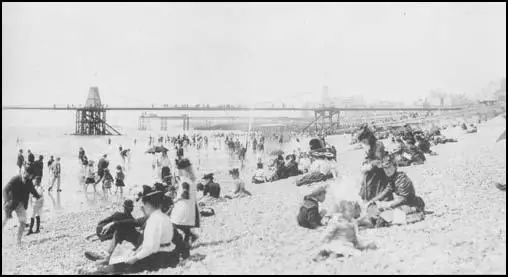 Holidaymakers
on Brighton Beach, to the east of the Royal Chain Pier. A
photograph taken by George Ruff junior before the Chain Pier
was destroyed by a storm on 4 December 1896. Holidaymakers
on Brighton Beach, to the east of the Royal Chain Pier. A
photograph taken by George Ruff junior before the Chain Pier
was destroyed by a storm on 4 December 1896.
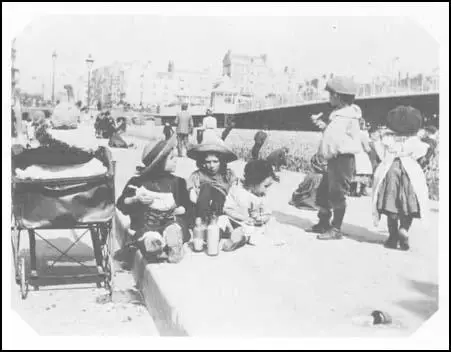
Children having a
picnic on the groyne which ran alongside Brighton's Palace
Pier. A snapshot photograph taken by George Ruff junior around
1900.
|
1
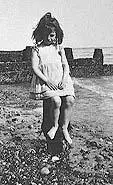
Snapshots
of children on Brighton Beach. Photographs
taken by George Ruff junior in the early 1900s.
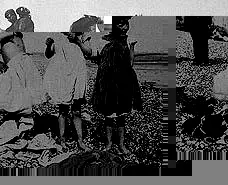
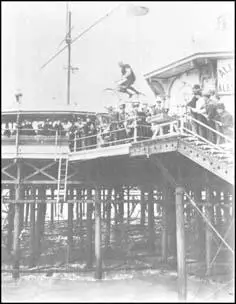
George Ruff junior's
camera captures the moment when Professor Reddish takes off
from the West Pier on his bicycle. A photograph dated 17 June
1904.
|
George
Ruff junior was not a professional photographer. As a man of independent
means , George Ruff junior was a "gentleman amateur", who took an
active part in the Hove Camera Club ( a fellow member was Charles
Job, a stockbroker who lived in Hove and exhibited with the artist-photographers
of The Linked Ring group ). Although interested in the "snapshot"
as a means of capturing the moment and documenting everyday life,
George Ruff also exhibited more orthodox photographs at the Hove Camera
Club. He submitted photographs of rural scenes such as ploughing with
horses and sheep grazing on the Downs.
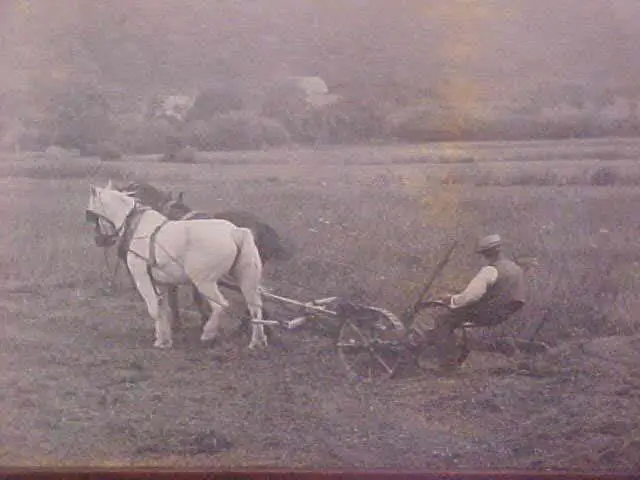
Ploughing,
a photograph exhibited at Hove's Camera Club by George Ruff junior
around the year 1905. On the back of the photograph the exhibitor's
label reads " G. Ruff, 1 Chatsworth Road."
In 1905, George Ruff junior moved from Coventry Street to a house
a few streets away in Chatsworth Road, near Dyke Road Park. Mr G Ruff
is listed as head of household at 1 Chatsworth Road, Preston, Brighton
from 1905 to 1913. George Ruff junior appears on Brighton & Hove's
Voting Lists for the last time in 1913. From 1913 to 1915, Mrs M Ruff
is the only name listed at 1 Chatsworth Road in local street directories
and so we can assume George Ruff junior died around 1913.
|
Ed
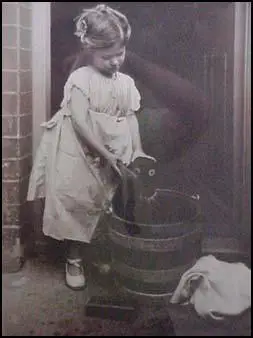
Photograph
of George Ruff junior's adopted daughter Dorothy washing her
toy "golliwog".
|
1
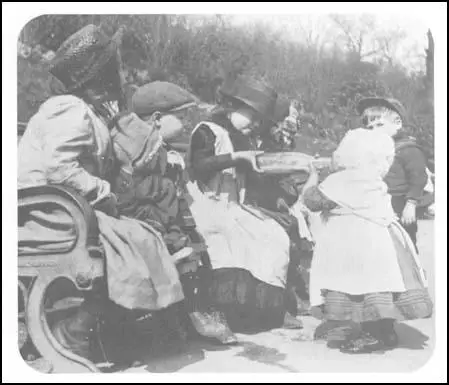
Children
in Brighton's Queens Park, captured in a photograph taken
by George Ruff junior around the year 1900.
|
Acknowledgements
Thanks
to Philippe Garner for permission to use photographs from his collection.
I
can recommend Philippe Garner's excellent book "A Seaside
Album : Photographs and Memory", published by Philip Wilson
Publishers in association with The Royal Pavilion, Libraries &
Museums, Brighton & Hove (2003).